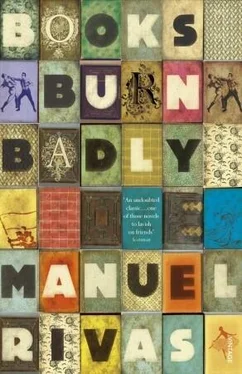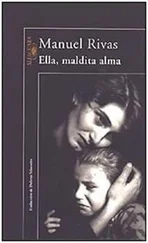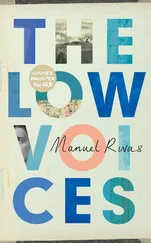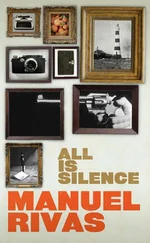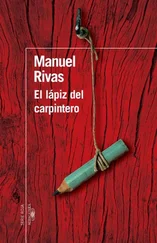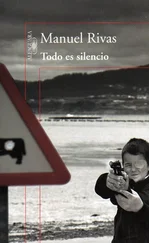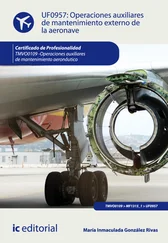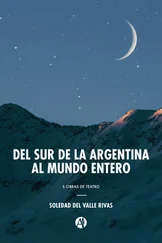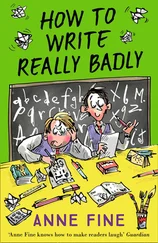‘I was thinking, about the Loch Ness monster, I was thinking we also had a sea monster.’
‘Yeah, right. Leviathan and all that. Where there’s sea. .’
‘I’m serious, Don Ovidio. You know the painter Sada?’
‘I know him.’
‘He painted it in his own way. More like a serpent than a whale. He calls it Antaruxa. Because of something he experienced as a child. It turned up in Coruña Bay, after a storm during which the waves, to use the popular expression, climbed the clouds of the sky. They say it whizzed up the Gulf Stream, first went round and round Marola Isle like a big wheel and, on the second day, entered the docks. People could touch it. It was very calm. Actually it was more like a whale than a sea serpent. A snow-white whale. Its eyes were two luminous slits, an emerald green. With two large black stains like sickle-shaped leaves on top of them. It never broke anything. It acted as if it had come to visit the city. According to the eye-witness accounts I’ve seen, it spent all its time gazing at the windows. But some considered it a kind of Kronosaurus, with huge canines a metre long, which would mash up the whole Sea Club’s team. Not at all. It was very artistic. Most people applauded the miracle. But those who thought it a monster got their own way. A company of carabineers was dispatched and an officer gave the order to fire. They shot it. Right here, in the heart of the city, they blew our myth to smithereens.’
‘That’s a terrible story. I never heard anything like it. What can that inebriated boat, Sada, have been drinking?’
‘A cup of red wine, but he barely touched it. He’d wet his fingers and paint with them on the marble table. As the girls in Two Cities say, it’s a shame these masterpieces only last a day. Though this was a cruel painting. All the wine turned into blood. You should have seen it. He’d come to, stand up and shout, “Ready! Aim! Fire! Destroy the miracle!” That’s right. He’d shout there were no sirens left in Galicia because we’d eaten them all. He claimed one of the first canneries was for siren meat.’
‘That’s horrible. Grotesque. Pure showmanship. He should have stayed in his magical world.’
‘I didn’t believe him either, Mr Aldán. I thought it had to be an invention, all this about a whale in the docks, next to the glass galleries. But I was curious. I sifted through some papers and there it was. There was a strange whale, more albino than white, shot to pieces in the very docks of this city. It happened during the toughest part of the war, on the 6th of September 1938. People applauded when it appeared, causing waves that pushed back the guards. It must have sensed the popular support. Until the soldiers, in spite of the wave of boos, shot at it. It ejected water through its monumental siphon. They shot it again. And again. The docks were stained with cetacean blood. People were shocked, dismayed. I thought we could do a report. Create a legend. That of the whale which came to live in the heart of our city.’
‘And didn’t they say why?’ asked the director of the evening Expreso . ‘Why they killed it in this way.’
He suddenly realised he’d fallen into a trap. ‘Forget I asked. And forget about extraterrestrials, the Beatles. . and endearing sea monsters riddled with bullets.’
Stringer decided to carry on. ‘No, Mr Aldán. They didn’t say why. But we could bring the story back to life, create a legend. Have our own monster. Almost all civilisations have imagined a colossal creature. The Scandinavians have the Kraken, with its luminous eyes and gigantic tentacles. There’s Bigfoot in North America. The Yeti in the Himalayas. There are even souvenirs with photos of its footprints in the snow. I think they’re made up, like dragons, unicorns or sirens. But ours is real. This mysterious and intelligent sea creature, the size of an enormous whale, actually existed. Paid us a visit. Wanted to stay. People clapped when it arrived.’
‘What’s the point of a myth if we killed it? Maybe if someone else had killed it. Almanzor, Napoleon, Hitler, Stalin. . But like this, that’s some propaganda!’
‘What if it never died?’
‘Did it die or didn’t it?’
‘We could write the story. With their applause, their cheers, the people managed to stop the shooting. A sensible officer, wary of public opinion and himself amazed by the creature, its mythical deportment, revoked the order and granted a pardon. The whale healed. Doctor Rodríguez from the Tobacco Factory came and healed it.’
‘Now we’re out of reality.’
As Stringer told the story, so he began to believe it. He understood Sada’s passionate recreation, the vision in his eyes of Antaruxa, that sea-witch, that stylised cetacean the narwhals escorted to the invisible line drawn by Marola Isle and Hercules Lighthouse. Sada could paint it because he’d seen it. As he talked at the furthest table in the Supply bar, he traced its erotic lines in the ephemeral nobility of red wine on marble:
‘That’s it. The curve, our great contribution to the history of the line, the curve that even stuck to the tongue, as Unamuno said, of Ramón María del Valle-Inclán, who wrote with curves as Don Miguel wrote with frets. This is memory talking and writing in waves, curls, loops, spirals, helicoid, sigmoid literature, the songbooks’ leixapren, the fingers, ah, where are the fingers of the one “sitting at St Simon’s Chapel, caught by the waves, how tall they seem”, Sapphic fingers drawing concentric circles, inward spirals? All rock-carvings are really astrographs. The first writing, the first art, the first topography, the first house: always circles, groups of circles. Hill-forts. Huts. The inner curve, Mogor’s labyrinth, humanity’s first neural incision. The whole monoecious coast, phallic vulva, pornographic nation fertilising shoals underwater. . When was Galicia fucked? The terrible day of the square, more or less.’
Sada fell quiet. He had bursts of energy and bouts of melancholy, like a speech warrior suffering from cyclothymia. In the way he talked, there was something of a phosphorescent diver’s movements since he’d emerge in a sea of pyrotechnics, then suddenly mist. The curtain falls.
Why not create the legend of a city born from a whale? There were historical data. Evidence, proof, that didn’t exist in the case of the tenant of Loch Ness. And the whale was female.
The director of the evening Expreso stood up to stretch his legs. What did this novice know about monsters and monstrosities? Right here in the docks, where the soldiers shot the whale the people applauded during the toughest part of the war, two years earlier, at the start of a new dictatorship, they’d burnt books from cultural associations and public libraries. He remembered that. The memory was accompanied by the smell of old, bound smoke. A sudden mist had entered his office. The director criticised his secretary for using a ventilator — ‘A ventilator in the city of winds!’ — and continued by attacking the country’s capricious climate, partly to blame, so he believed, for the problems of circulation. On days of rain, sales dropped off dramatically. Culture versus nature. He rapped the table. Suddenly viewed Stringer suspiciously, like someone who’s woken from a nightmare to find the culprit standing there. ‘That’s horrible. Listen to me. Forget about that story. It never happened and can’t appear.’ In a whisper, ‘Have you any idea how the Caudillo catches cetaceans from his yacht? Not with a harpoon exactly. Forget about such battlefields. How are we going to run with a story about a whale that’s been shot at? You have to start to distinguish between what you can and cannot tell. My dear friend, allow me to give you a word of advice, if not as an expert, then as a veteran. There are times a good journalist must separate the grain from the straw, so that he can publish the straw. Don’t make the reader suffer. He knows he’s living in a valley of tears. So cheer us up a little. Here. Tell us about the day the town hall dressed up rugged Coruñan sailors as Venetian gondoliers to welcome the Duke and Duchess of Lancaster. How they sang sweet, rhythmical barcaroles, rowing on their feet without even breaking into a sweat.’
Читать дальше
